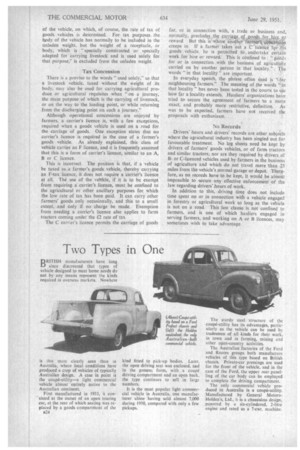Two Types in One
Page 98

If you've noticed an error in this article please click here to report it so we can fix it.
BR1T1SH manufacturers have long since discovered that types of vehicle designed to meet home needs do not by any means represent the kinds required in overseas markets. Nowhere
is this more clearly seen than in Australia, where local conditions have produced a crop of vehicles of typically Australian design. A case in point is the coupe-utility—a light commercial vehicle almost entirely native to the Australian continent.
First manufactured in 1933, it consisted at the outset of an open touring car, at the rear of which seating was replaced by a goods compartment of the B24
kind fitted to pick-up bodies. Later, the open driving seat was enclosed, and in the present form, with a coupe driving compartment and an open back. the type continues to sell in large numbers.
It is the most popular light commercial vehicle in Australia, one manufacturer alone having sold almost 7,000 during 1950, compared with only a few pick ups.
The sturdy steel structure of the coupe-utility has its advantages, particularly as the vehicle can be used by tradesmen of all kinds for their work, in town and in farming, mining and other open-country activities.
The Australian factories of the Ford and Rootes groups both manufacture vehicles of this type based on British chassis. Private-car pressings are used for the front of the vehicle, and in the case of the Ford, the upper rear panelling of the ear body can be employed to complete the driving compartment.
The only commercial vehicle produced in Australia is a coupe-utility. Manufactured by General MotorsHolden's, Ltd., it is a chassisless design,
poNered by a six-cylindered, 2-litre eneine and rated as a 7-cwt. machine.












































































































































